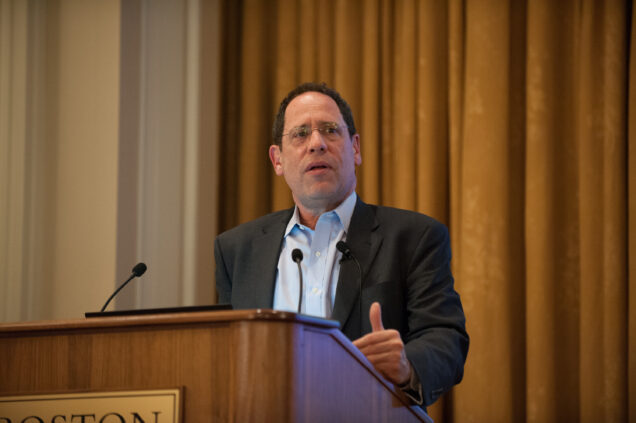Bruce Katz and “The New Localism”

On February 28th, Bruce Katz, former Centennial Scholar at the Brookings Institution, visited Boston University to discuss his new book “The New Localism: How Cities Can Thrive in the Age of Populism,” which offers a practical road map for cities to plan and fund the future.
As the federal government “leaves the building,” cities are expressing more autonomy as hubs of innovation and productivity. Katz defines this emerging power as the new localism: city-level problem solving in a multi-sector, network economy.
“As our federal government becomes a health insurance company with an army, you have to figure out different ways of funding the future,” said Katz.
Industry Investment
Pittsburgh’s geography of universities, corporations, start-ups, and investors all in close proximity is the “secret sauce” to the city’s growth, says Katz. Companies like GE, Google, and Uber are moving in to the once desolate steel town to take advantage of the budding tech networks.
“It’s a platform for innovation,” said Katz. “This is smart, strategic development.”
Katz credits Pittsburgh’s rebirth to informal networks of institutions investing in new technologies, such as autonomous vehicles, 3D printing, and genomics. The city was able to transition “from Rustbelt to Brainbelt” by building on its geographic strength and supporting 21st century industries.
Multi-sectoral Collaboration
Indianapolis, on the other hand, transitioned “from basketball to biotech.” The Central Indiana Corporate Partnership, or CICP, regularly brought together 60 multi-sectoral executives to discuss innovation to benefit urban life.
“You’re not going to be the next Silicon Valley,” said Katz. “But you could be the best 21st century version of yourself.”
Backed by private and civic capital, the state grew to become the second largest exporter of life science products, after California. Indianapolis’s formal collaboration structures helped propel itself into a booming, innovative city.
Finance Tools
In the mid 1980s, Copenhagen faced a $750 million annual budget deficit. Its solution was to reclaim public wealth and manage its assets to best benefit the city. Its government merged multiple entities to become publicly owned but professionally managed, thus insulated from politicians.
“In the U.S., the left tends to fetishize government, no matter how mediocre. The right fetishizes privatization, no matter how rapacious,” said Katz. “[Copenhagen] figured out a hybrid model.”
Copenhagen utilized land on its harbor to build valuable infrastructure to sell to private parties. Those revenues have been sufficient enough to service the debt of its new subway system, a concept unheard of in America, where taxes are often raised to pay for public projects. Copenhagen, on the other hand, figured out a solution to manage its assets to benefit the public for the long-term.

Boston’s Goals
Katz tasked Boston with figuring out exactly who’s in charge: not just government officials, but other leaders in the private, community, and university sectors to work together. City Councilor At-Large Michelle Wu asked Katz how to close to gap between different generations’ goals.
“There’s so much sitting on the shoulders of folks at the city level now,” said Wu. “Do you have any advice on how city government should be thinking about who we are making these decisions for?”
Since elected officials have democratic legitimacy, Katz suggested mayors and city councilors to “use their soft power to organize a broader set of stakeholders.” In summary, having a full table is never a bad thing. There will be moments that constituencies have conflicting interest, Katz said, so your goal is to bring folks together on what they can agree on and then negotiate the rest.
Taking lessons from cities like Pittsburgh, Indianapolis, and Copenhagen, Boston must invest in innovation, create formal collaboration networks, and find funding through public assets in order to harness the power of the new localism.
“We’re in a world where it’s not just partisan division or ideological polarization,” said Katz. “It’s the capacity to think across disciplines, across sectors, take risks. That’s all local now.”
Watch the lecture below: